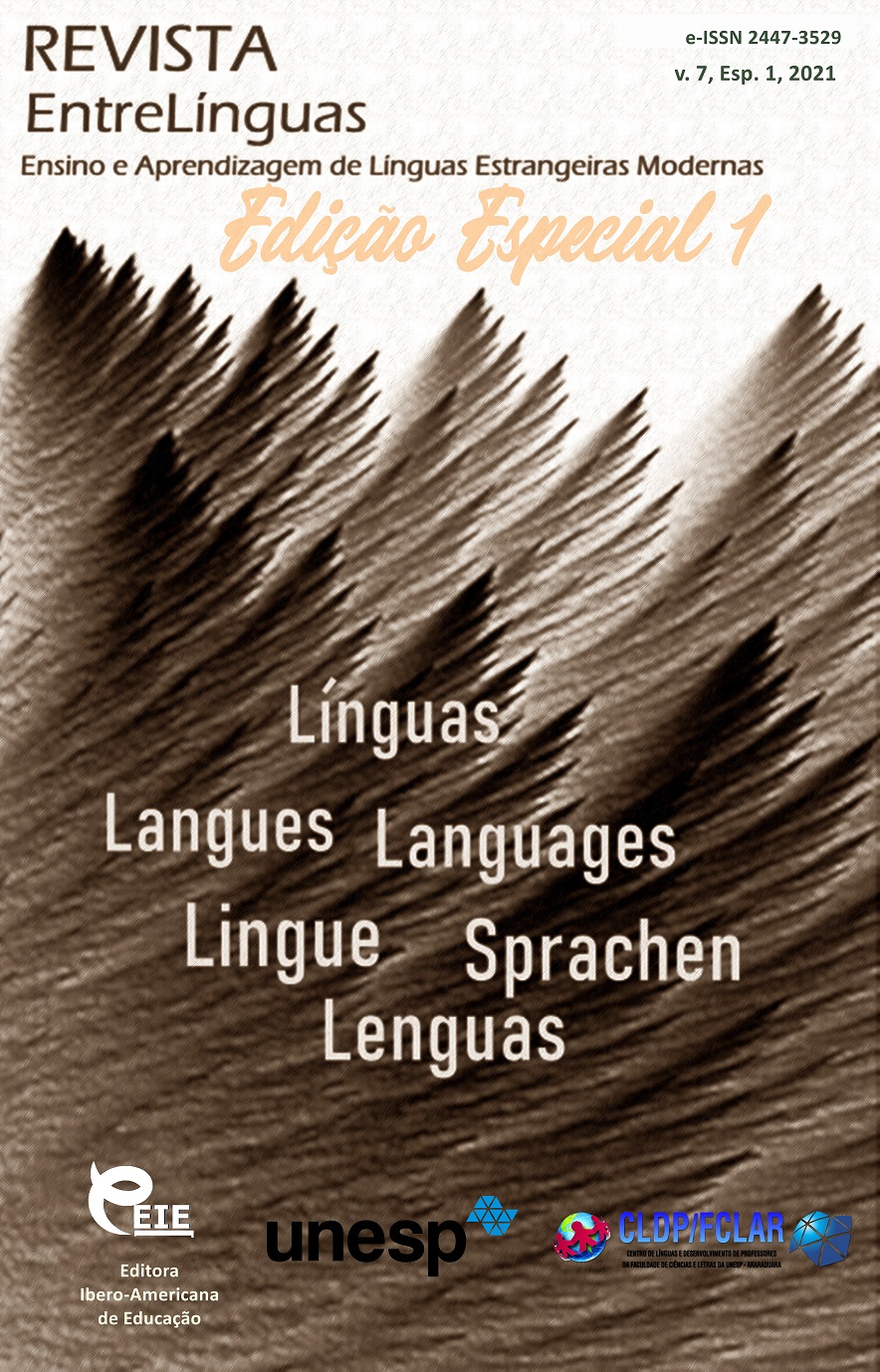Representação da linguagem de percepção visual no sistema verbal da língua Tartára
DOI:
https://doi.org/10.29051/el.v7iEsp1.14875Palavras-chave:
Verbo, Semântica, Verbos de percepção visual, Linguagem tártara, FraseologiaResumo
Este artigo apresenta os verbos, que definem processos cognitivos. A atividade cognitiva começa com sensação e percepção; existem também percepções visuais, auditivas e outras. O objeto deste estudo são os verbos de percepção visual e sua representação no sistema verbal da língua tártara. Na língua tártara, funcionam vários verbos, expressões verbais e unidades fraseológicas que refletem várias nuances da percepção visual. A relevância do tema reside no fato de que os traços semântico-funcional, estrutural-derivacional dos verbos de percepção visual, que constituem uma parte significativa da estrutura lexical da língua tártara, não foram estudados. O estudo das peculiaridades semânticas e de formação de palavras contribui para a análise mais completa e abrangente da composição lexical da língua tártara. As conclusões tiradas durante o estudo são importantes para a construção de interpretações dos verbos de visão, para a descrição integral da gramática. Alunos e professores da língua tártara podem usar o material apresentado em sala de aula. O artigo fornece todos os significados e nuances dos verbos de percepção visual, o que aumenta principalmente o limiar de dificuldade na percepção adequada e no processo de aprendizagem deste material no curso de ensino da língua tártara como língua estrangeira. Os resultados podem ser aplicados ao desenvolvimento de manuais linguodidáticos, dicionários e livros de referência para o ensino eficaz da língua tártara.
Downloads
Referências
DMITRIEV, N. K. System of the turkic languages. Moscow: Publishing House of East Literatures, 1962. 607 p.
GALIMOVA, G. N., YUSUPOVA, A. S.; NABIULLINA, G. A.; Mustafa oner “ethnic stereotypes of communicative behavior in paroemiological fund of the tatar and turkish languages. Modern Journal of Language Teaching Methods, v. 8, n. 9, р. 18-23, 2018.
GILAZETDINOVA, G. K.; SALAKHOVA, R. R. Lexical-semantic groups of the verbs of motion in structurally different languages (On the material of the russian and the tatar languages). XLinguae, v. 11, n. 4, p. 32-44, 2018.
HANBIKOVA, S. S.; SAFIULLINA, F. S. Dictionary of synonyms of the Tatar language. Kazan, 2014. 263 p.
IZBASAROV, D.; Islamova, E. A.; BOLGAROVA, R. M. The Associative Field Of the 9. lexemes work in russian and tatar language consciousness. Revista publicando, v. 4, n. 13, p. 507-516, 2017.
KABIROVA, A. A. et al. Educational Internet Resources in Turkic Languages. HELIX, v. 8, n. 1, p. 2469-2472, 2018.
KAZAN, T. G. Tatarsky kn. Morphology. 1997. T. II. 397 р.
KAZAN, T. I. Explanatory dictionary of the tatar language. 2015. 712 p.
KHASANZYANOVA, G. I.; ISLAMOVA, E. A.; BOLGAROVA, R. M. Man in the mirror free association experiment. AD ALTA-Journal of Interdisciplinary Research, v. 8, n.1, p. 190-192, 2018.
KULIEV, G.K. Semantics of verbs in the turkic languages. Abstract of dissertation Doctorate in Philological Sciences. Baku, 1992. 47 p.
YERBULATOVA, I. K et al. Culture-specific terms as verbal expressive peculiar features of national cultures. Astra Salvensis, v. 10, р. 123-130, 2017.
ZAMALETDINOV, R. R.; FAIZULLINA, G. C.; FATTAKOVA, A. A. “phraseological units of the siberian tatars with the component-somatism ec belly, formed on the basis formulas of the evil desire. Modern Journal of Language Teaching Methods, v. 8, n. 11, p. 272-277, 2018.
Downloads
Publicado
Como Citar
Edição
Seção
Licença

Este trabalho está licenciado sob uma licença Creative Commons Attribution-NonCommercial-ShareAlike 4.0 International License.
Os manuscritos aceitos e publicados são de propriedade da Revista EntreLínguas. Os artigos publicados e as referências citadas na Revista EntreLínguas são de inteira responsabilidade de seus autores.
Transferência de direitos autorais – autorização para publicação
Caso o artigo submetido seja aprovado para publicação, já fica acordado que o(s) autor(es) autoriza(m) a UNESP a reproduzi-lo e publicá-lo na EntreLínguas, entendendo-se os termos “reprodução” e “publicação” conforme definição respectivamente dos incisos VI e I do artigo 5° da Lei 9610/98. O artigo poderá ser acessado pela rede mundial de computadores (Internet), sendo permitidas, a título gratuito, a consulta e a reprodução de exemplar do artigo para uso próprio de quem a consulta, desde que haja a citação ao texto consultado. Essa autorização de publicação 328 EntreLínguas, Araraquara, v. 1, n .2, p. 323-328, jul./dez. 2015 não tem limitação de tempo, ficando a UNESP responsável pela manutenção da identificação do(s) autor(es) do artigo. Os artigos publicados e as referências citadas na Revista EntreLínguas são de inteira responsabilidade de seus autores.











